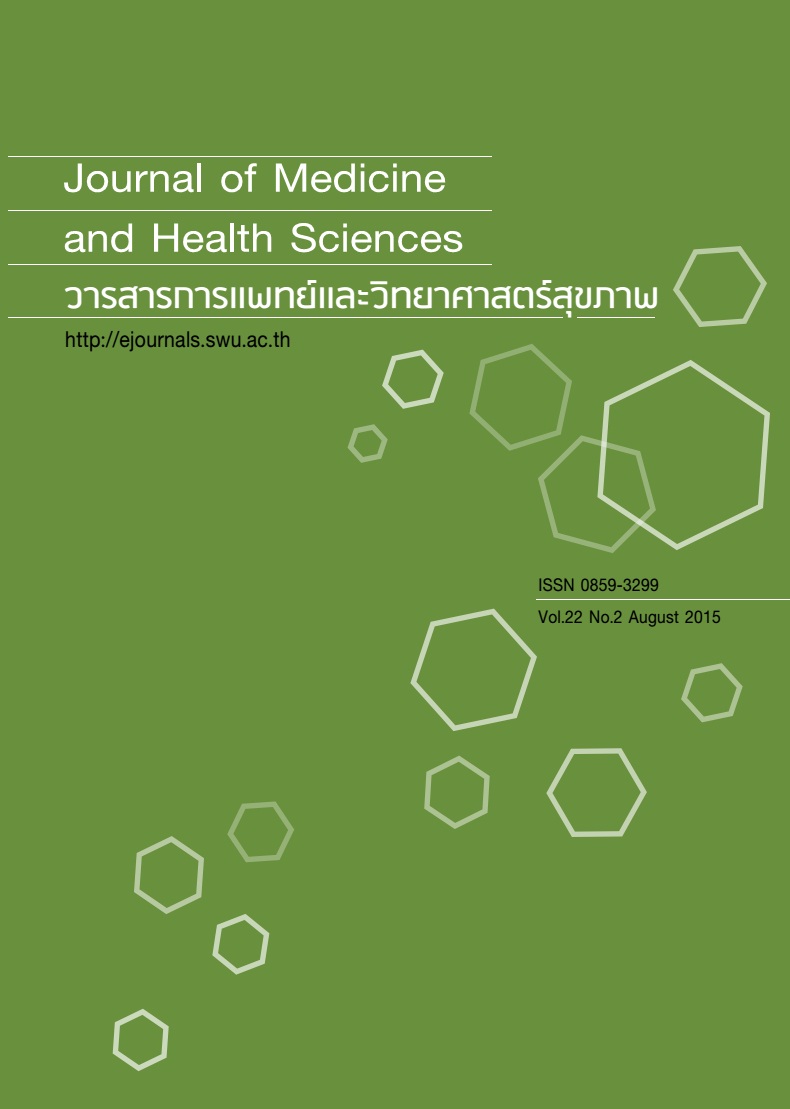Trehalose biosynthesis pathway as a promising new target for antifungal drug development
Keywords:
น้ำตาลทรีฮาโลส, โรคติดเชื้อราในระบบต่างๆ, ยาต้านเชื้อรา, Trehalose, Systemic mycoses, Antifungal drugAbstract
High mortality rates associated with systemic mycoses have dramatically increased in immunocompromised patients. With limitedly available antifungal drugs and their adverse drug reactions, much effort is being focused on new antifungal drug development. Fungi have evolved multifactorial mechanisms to survive various stress conditions encountered in the environment and in vivo during infection. Targeting the biochemical pathways utilized by the fungus to adapt to stress conditions is one proposed approach for the development of new antifungal drugs. Biosynthesis of the disaccharide trehalose is one such target that is not found in humans. The TPS/TPP pathway is the main mechanism fungi utilized for trehalose biosynthesis and has been found to have a critical role in regulating fungal metabolic homeostasis and integrity of fungal cell wall. Mutants tps2 and trehalose-6-phosphate phosphatase activity displayed an increased accumulation of trehalose-6-phosphate intermediate, cell wall alteration, and attenuation of the virulence in the murine models of systemic mycoses. The consistent results were found in human fungal pathogens; Candida albicans, Cryptococcus neoformans, and Aspergillus fumigatus suggesting that the trehalose biosynthesis pathway is a promising target for antifungal drug development. However, finding a broad spectrum fungicidal drug against human fungal pathogens must also consider the outcome on the pathogenic dimorphic fungi. Importantly, the consequences of host immune responses against fungi must also be taken into account when the fungal cell wall exhibits changes through the inhibition of the trehalose biosynthesis pathway.
กระบวนการสังเคราะห์น้ำตาลทรีฮาโลสกับเป้าหมายใหม่เพื่อการพัฒนายาต้านเชื้อรา
อัตราการตายเนื่องจากภาวะติดเชื้อราในระบบต่างๆ (systemic mycoses) เพิ่มสูงขึ้นมากในผู้ป่วยที่มีภาวะ ภูมิคุ้มกันบกพร่อง ในขณะที่ยาต้านเชื้อราที่มีประสิทธิภาพในการรักษามีจำกัดและมีผลข้างเคียงค่อนข้างรุนแรง ทำให้มีการ พัฒนายาต้านเชื้อราชนิดใหม่ ปัจจัยสำคัญที่การพัฒนายาต้องพิจารณาคือความสามารถของเชื้อราในการวิวัฒนาการกลไก ต่างๆ เพื่อการอยู่รอดเมื่อต้องเผชิญหน้ากับสภาวะเครียดและไม่เหมาะสมต่อการเจริญในสิ่งแวดล้อมและในร่างกายมนุษย์ ดังนั้น เป้าหมายหลักของการพัฒนายาต้านเชื้อราจึงมุ่งไปที่กระบวนการทางชีวเคมีของเชื้อราที่สำคัญในการปรับตัวภายใต้ สภาวะเครียด กลไกที่น่าสนใจที่พบในเชื้อราแต่ไม่พบในมนุษย์คือกระบวนการสังเคราะห์น้ำตาลโมเลกุลคู่ทรีฮาโลส (trehalose) โดยเชื้อราใช้Trehalose-6-Phosphate Synthase/Trehalose-6-Phosphate Phosphatase pathway เป็นกระบวนการหลักในการสังเคราะห์น้ำตาลนี้ พบว่ากระบวนการนี้เกี่ยวข้องกับกลไกการควบคุม เมตาบอลิซึมอื่นๆ และการสร้างผนังเซลล์ของเชื้อราด้วย การทำให้เชื้อรามียีน tps2 กลายพันธุ์ (mutant) จนไม่สามารถสร้างเอนไซม์ทรีฮาโลสซิกส์ฟอสเฟตฟอสฟาเทส (trehalose-6-phosphate phosphatase) จะส่งผลให้เกิดการสะสม trehalose-6-phosphate จนมีผลให้ส่วนประกอบของผนังเซลล์ผิดปกติและลดความรุนแรง ในการก่อโรคในหนูทดลอง โดยลักษณะที่เปลี่ยนไปเหล่านี้พบในเชื้อราก่อโรคในมนุษย์สามชนิด คือ Candida albicans, Cryptococcus neoformans และ Aspergillus fumigatus ผลที่ได้นี้สนับสนุนการพัฒนายาต้านเชื้อราที่ยับยั้งการทำงาน ของเอนไซม์ทรีฮาโลสซิกส์ฟอสเฟตฟอสฟาเทส อย่างไรก็ตาม ควรมีการศึกษาเพิ่มเติมถึงประสิทธิภาพในการรักษาเชื้อรา กลุ่ม dimorphic fungi ที่ก่อโรคในมนุษย์ด้วย และต้องศึกษาผลของระบบภูมิคุ้มกันต่อเชื้อราที่มีผนังเซลล์ผิดปกติจากการ ยับยั้งการทำงานของเอนไซม์นี้



